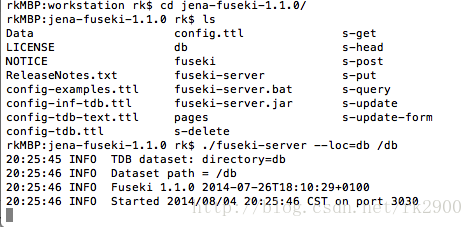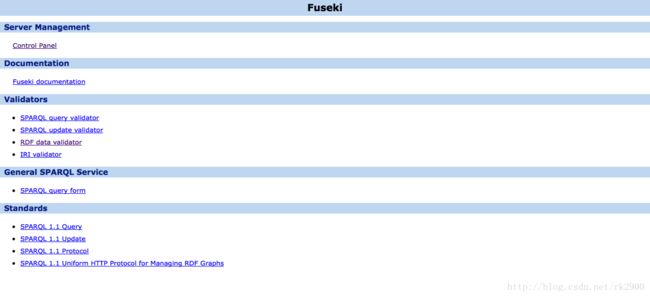【Jena使用手册】用Python访问Apache Jena数据库 利用Fuseki搭建HTTP访问服务器
在上一篇博文中我们已经探讨了如何通过Jena的命令行工具构建TDB数据库,并导入RDF数据。
本文讨论通过Fuseki构建基于HTTP的RDF查询、修改框架,最终可以通过Python构建SPARQL查询,访问RDF Triple Store获取结果。
1、运行Fuseki
首先下载Fuseki,下载地址,解压。
我们暂且将上一篇文章中构建的Triple Store文件夹db/放入Fuseki所在文件夹。
我们可以通过Fuseki Server脚本运行这个服务,具体的指令可以是以下几种:
fuseki-server --mem /DatasetPathName
fuseki-server --file=FILE /DatasetPathName
fuseki-server --loc=DB /DatasetPathName
fuseki-server --config=ConfigFile--port=PORT是指定端口的指令,默认3030;
/DatasetPathName是指定数据库的名字;
官网有下面的一段说明,可以参考:
--mem
Create an empty, in-memory (non-persistent) dataset.
--file=FILE
Create an empty, in-memory (non-persistent) dataset, then load FILE into it.
--loc=DIR
Use an existing TDB database. Create an empty one if it does not exist.
--desc=assemblerFile
Construct a dataset based on the general assembler description.
--config=ConfigFile
Construct one or more service endpoints based on the configuration description.我们这边已经有了导入过数据的TDB数据库,这样我们就使用下面这行命令:
./fuseki-server --loc=db /db这里的--loc参数的值可以是d:\data\dbpedia\3.0\db,而最后一个参数是HTTP接口的对应访问路径,例如通过localhost:3030/db/query进行SPARQL查询。
这里要注意的是最后一个参数/db前面的“/”不能遗漏,否则启动失败。
此时打开浏览器访问:localhost/3030,会看到如下界面:
在这个网页端接口中,能够通过GUI进行SPARQL查询、更新等。
查询的网址:localhost:3030/db/sparql
如果要使Fuseki服务器支持多个不同的datasets同时能够被查询,那么需要使用config文件。
使用命令:
D:\jena-fuseki-1.1.1>fuseki-server.bat --config=config-multiTDB.ttl配置多个datasets的config文件如下:config-multiTDB.ttl
# Licensed under the terms of http://www.apache.org/licenses/LICENSE-2.0
## Example of a TDB dataset published using Fuseki: persistent storage.
@prefix : <#> .
@prefix fuseki: .
@prefix rdf: .
@prefix rdfs: .
@prefix tdb: .
@prefix ja: .
[] rdf:type fuseki:Server ;
# Timeout - server-wide default: milliseconds.
# Format 1: "1000" -- 1 second timeout
# Format 2: "10000,60000" -- 10s timeout to first result, then 60s timeout to for rest of query.
# See java doc for ARQ.queryTimeout
# ja:context [ ja:cxtName "arq:queryTimeout" ; ja:cxtValue "10000" ] ;
# ja:loadClass "your.code.Class" ;
fuseki:services (
<#dbp30>
<#dbp37>
<#dbp39>
<#yago2s>
) .
# TDB
[] ja:loadClass "com.hp.hpl.jena.tdb.TDB" .
tdb:DatasetTDB rdfs:subClassOf ja:RDFDataset .
tdb:GraphTDB rdfs:subClassOf ja:Model .
## ---------------------------------------------------------------
## Read-only TDB dataset (only read services enabled).
<#dbp30> rdf:type fuseki:Service ;
rdfs:label "DBpedia3.0" ;
fuseki:name "dbp30" ;
fuseki:serviceQuery "sparql" ;
fuseki:dataset <#dbpedia_30> ;
.
<#dbpedia_30> rdf:type tdb:DatasetTDB ;
tdb:location "D:\\kren\\data\\dbpedia\\3.0\\db" ;
## tdb:unionDefaultGraph true ;
.
## ---------------------------------------------------------------
## Read-only TDB dataset (only read services enabled).
<#dbp37> rdf:type fuseki:Service ;
rdfs:label "DBpedia3.7" ;
fuseki:name "dbp37" ;
fuseki:serviceQuery "sparql" ;
fuseki:dataset <#dbpedia_37> ;
.
<#dbpedia_37> rdf:type tdb:DatasetTDB ;
tdb:location "D:\\kren\\data\\dbpedia\\3.7\\db" ;
## tdb:unionDefaultGraph true ;
.
## ---------------------------------------------------------------
## Read-only TDB dataset (only read services enabled).
<#dbp39> rdf:type fuseki:Service ;
rdfs:label "DBpedia3.9" ;
fuseki:name "dbp39" ;
fuseki:serviceQuery "sparql" ;
fuseki:dataset <#dbpedia_39> ;
.
<#dbpedia_39> rdf:type tdb:DatasetTDB ;
tdb:location "D:\\kren\\data\\dbpedia\\3.9\\db" ;
## tdb:unionDefaultGraph true ;
.
## ---------------------------------------------------------------
## Read-only TDB dataset (only read services enabled).
<#yago2s> rdf:type fuseki:Service ;
rdfs:label "YAGO 2s" ;
fuseki:name "yago2s" ;
fuseki:serviceQuery "sparql" ;
fuseki:dataset <#yagodb2s> ;
.
<#yagodb2s> rdf:type tdb:DatasetTDB ;
tdb:location "D:\\kren\\data\\yago\\2s\\db" ;
## tdb:unionDefaultGraph true ;
. 在启动后我们能够在Fuseki的服务器panel中看到多个datasets的列表,同时能够支持多个datasets同时被查询、访问。
如有in-memory或者从文件形式数据库启动的需求,参考官方文档:http://jena.apache.org/documentation/serving_data/index.html#fuseki-configuration-file
2、Python进行SPARQL查询
在Python中,我们使用一个包:SPARQLWrapper,一个Python下面的SPARQL查询终端,下载地址在这里。
在主页上有一段测试代码,我们略微做了一些修改:
from SPARQLWrapper import SPARQLWrapper, JSON
# sparql = SPARQLWrapper("http://dbpedia.org/sparql")
sparql = SPARQLWrapper("http://localhost:3030/db/query")
sparql.setQuery("""
PREFIX rdfs:
SELECT ?s
WHERE { ?s ?p ?o .}
LIMIT 3
""")
sparql.setReturnFormat(JSON)
results = sparql.query().convert()
for result in results["results"]["bindings"]:
print(result["s"]["value"]) 通过命令行运行Python解释器解析脚本获得输出结果如下:
通过以上结果我们可以发现已经成功获得查询结果。而代码中“http://localhost:3030/db/query”是Fuseki HTTP server中我们的数据库/db的查询接口。
其它接口罗列如下:
SPARQL query: http://localhost:3030/db/query
SPARQL update: http://localhost:3030/db/update
SPARQL HTTP update: http://localhost:3030/db/dataFuseki相关文档:http://jena.apache.org/documentation/serving_data/#running-a-fuseki-server
SPARQLWrapper相关文档:http://rdflib.github.io/sparqlwrapper/


